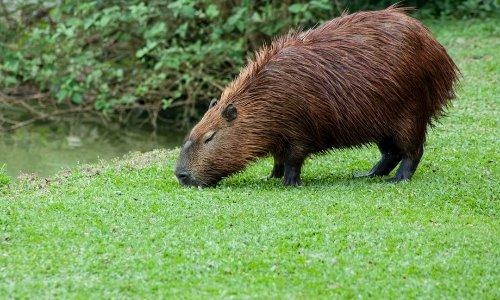The beaver often referred to as the genus Castor is commonly viewed as a large nocturnal rodent primarily terrestrial spending a large amount of time underwater.
Today the beaver exists in two singular species, the first of which is known as the North American beaver native to the regions North America where they are referred to as Castor canadensis due to their association with the Canadian region, and the Eurasian beaver often found in the regions of Europe and Asia where the species is traditionally known as the Castor fiber.
Facts about Beavers
▪ Beavers are most renown for building canals, lodges and dams.
▪ They are the second largest of the rodent family to the Hydrochoerus hydrochaeris the beaver has been known to build a number of dams specifically for the purpose of a protective measure against predators as well as a means of transporting building materials and food by float.
▪ The beaver population within the North American region in 1988 was between six to twelve million resulting in sharp decline from over sixty million due to the species being extensively hunted for their glands used for medicinal purposes and manufacture of perfume, their fur and additionally due to the species harvesting of trees and continual flooding of rivers and canals obstructing the use of land by settlers.
▪ The strong teeth of the beaver is typically used to cut plant and trees which are generally used for the purpose of providing food and building their lodges.
▪ In areas where ponds are nonexistent the beaver will construct a dam before building a lodge. Poles after being cut by the beaver are placed vertically and horizontally filled in-between using a number of branches placed in a crisscross pattern. Small gaps between the branches are then packed with a mixture of mud and weeds until the dam built encloses a sufficient amount of water to encircle the lodge.
▪ Beavers when frightened are known for providing an noticeable alarm signal as a warning to beavers within the area by quickly diving into the water and using its broad tail to forcefully strike the water creating a loud and resonating disturbance often heard for miles both above and below the water surface. Beavers when alerted by such a warning will immediately duck below the water surface remaining submerged for a long as fifteen minutes.
▪ The beaver does not hibernate but will stockpile logs and sticks in their ponds above water often accumulating snow during the winter seasons. This provides a means of insulation for their lodge additionally preventing the water around the food stored from freezing. ▪ The beaver has a broad scaly tail, and webbed hind feet. Although they generally have poor eyesight, they are fitted with a keen sense of touch, hearing and smell. Their teeth will continuously grow to accommodate their constant chewing on wood thus preventing them from becoming worn down.
▪ The average beaver will live up to a 24 year period kept in the wild with the typical adult consisting of a weight of fifty-five pounds. The female beaver has been observed to be comparatively or slightly larger than males which today is recognized as an uncommon trait among most mammals.
Beavers in Ellis Farm
Centrally located within the core Alberta Canada, the Ellis Bird Farm is a fully functional farm in addition to a non-profit institution committed to ensuring the preservation of wildlife animals such as beavers, Tree Swallows, Mountain Birds as well as a host of other native cavity-nesting birds.
The beaver cams of the Ellis Farm organization allows viewers to obtain a detailed view of the inner surroundings of the beaver lodges. The beavers fondly known as June and Ward have often been observed as spending a vast amount of time in their lodge with their four kits, Cutter, Chippity-do-dah, Chewey and Flapjack. irrespective of the high water levels surrounding the lodge.
The Ellis Bird Farm Far beaver Lodge additionally contains a second camera is positioned above an existing hole in the ice kept open by the beavers used for digging their way out in search for food during warmer climate. The foundation through the assistance of Ron Biel and Rick Zamenek has been hauling aspen trees in as a means of allowing the beavers to maintain their larder stockpile.
View Ellis Bird Farm webcam.
Beavers in Gatineau Quebec
The story surrounding the beavers found in the southwestern city of Gatineau located within Quebec Canada started more than eight years ago with a female beaver by the name of Pollux. Over time she found herself a mate and together they constructed a dam and lodge later expanding the family by giving birth to eight kits.
Currently live streaming of the beavers in Gatineau has been suspended for the beavers found in Gatineau for the winter season. However visitors are able to view pre recorded footage of the nursery and lodge.
View Beavers in Gatineau Quebec webcam.
The Martin Mere Beavers
Following an absence of more than a five hundred year period from the northwestern county of Lancashire England two European beavers Woody and Twiggy became the first resident beavers at the wetland nature reserve known as the Martin Mere.
Using a number of night vision cameras, the activities of these nocturnal rodents are captured and streamed online to a worldwide wide audience. Actively monitored by two cameras the beavers have been observed to become highly active after 9pm depending on the current weather condition where they can be seen diving underwater securing the lodge from potential attacks by predators, transporting food on large branches storing them outside the lodge, obstructing inflow pipes to construct a dam and communicating with each other by striking the surface of the water with their tails and diving afterwards.
This action has traditionally been observed as a method of warning each other in the presence of danger.
View The Martin Mere Beavers webcam.

